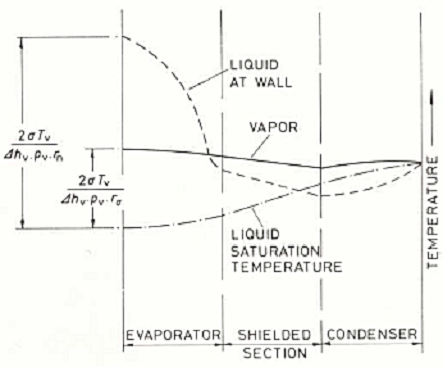Navigation by alphabet
A B C D E F G H I J K L M N O P Q R S T U V W X Y ZIndex
Temperature Distributions and Radial Heat Transfer
DOI 10.1615/hedhme.a.000312
3.10.3 Temperature distributions and radial heat transfer flux
D. Chisholm, Donatas Mishkinis
Figure 1 illustrates diagrammatically the variation of temperature of the fluid as it circulates around the heat pipe. Starting at the end of the condenser and following the direction of flow, the temperature of the liquid at the wall falls until the liquid reaches the exit from the condenser in the shielded section, the liquid temperature rises as a result of heat transfer from the vapor. In the evaporator, the liquid temperature rises quickly with heat transfer from the wall, until the liquid temperature is above the vapor temperature. As the pressure of the liquid in the evaporator is below that of the vapor, because of capillary forces, the saturation temperature of the liquid is below the vapor saturation temperature; thus in the evaporator the liquid is at a temperature above its saturation temperature. Boiling is suppressed because of surface tension forces on the nucleation sites, provided that the temperature difference over the wick is less than
\[\label{eq1}T_{wp}-T_{wv}=\frac{T_v}{\Delta h_v\rho_v}\left(\frac{2\sigma}{r_n}-\frac{2\sigma}{r_e}\right)\tag{1}\]
Following now the vapor flow from the end of the evaporator, the temperature drops along the flow path with falling pressure and heat transfer to the liquid, a small part of the vapor condensing in certain circumstances, until the inlet to the condenser is reached. In the condensing section there can be a slight temperature recovery associated with the pressure rise in the vapor.
... You need a subscriptionOpen in a new tab. to view the full text of the article. If you already have the subscription, please login here
